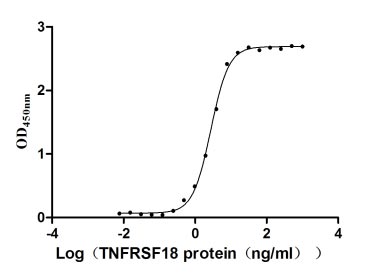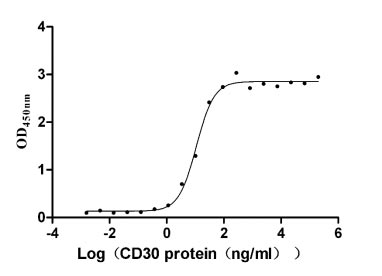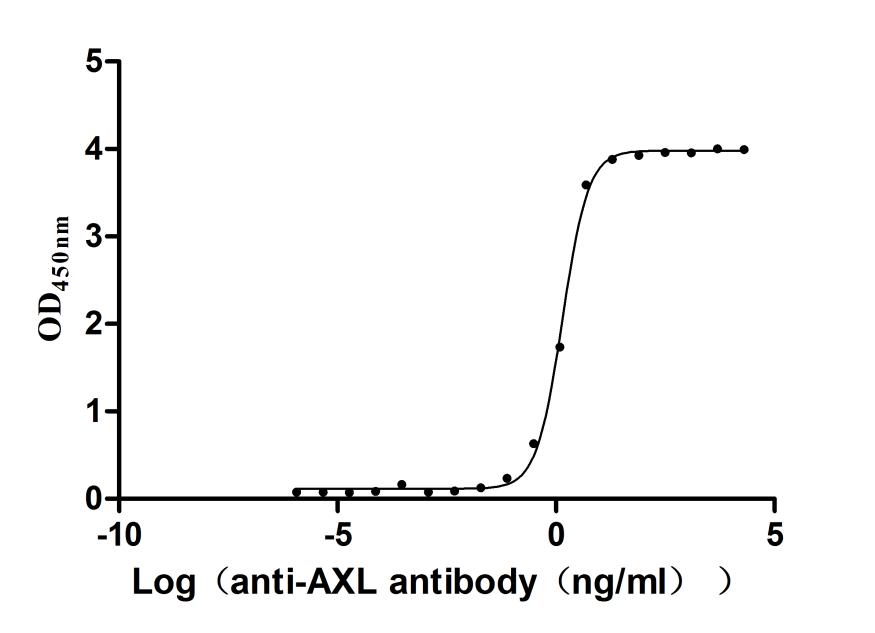Recombinant Human Tafazzin (TAZ), partial
-
货号:CSB-YP023181HU
-
规格:
-
来源:Yeast
-
其他:
-
货号:CSB-EP023181HU
-
规格:
-
来源:E.coli
-
其他:
-
货号:CSB-EP023181HU-B
-
规格:
-
来源:E.coli
-
共轭:Avi-tag Biotinylated
E. coli biotin ligase (BirA) is highly specific in covalently attaching biotin to the 15 amino acid AviTag peptide. This recombinant protein was biotinylated in vivo by AviTag-BirA technology, which method is BriA catalyzes amide linkage between the biotin and the specific lysine of the AviTag.
-
其他:
-
货号:CSB-BP023181HU
-
规格:
-
来源:Baculovirus
-
其他:
-
货号:CSB-MP023181HU
-
规格:
-
来源:Mammalian cell
-
其他:
产品详情
-
纯度:>85% (SDS-PAGE)
-
基因名:TAZ
-
Uniprot No.:
-
别名:Barth syndrome; BTHS; Cardiomyopathy dilated 3A (X linked); CMD3A; EFE; EFE2; Endocardial fibroelastosis 2; G4.5; LVNCX; Protein G4.5; Tafazzin; TAZ; TAZ protein; TAZ_HUMAN; Taz1
-
种属:Homo sapiens (Human)
-
蛋白长度:Partial
-
蛋白标签:Tag type will be determined during the manufacturing process.
The tag type will be determined during production process. If you have specified tag type, please tell us and we will develop the specified tag preferentially. -
产品提供形式:Lyophilized powder
Note: We will preferentially ship the format that we have in stock, however, if you have any special requirement for the format, please remark your requirement when placing the order, we will prepare according to your demand. -
复溶:We recommend that this vial be briefly centrifuged prior to opening to bring the contents to the bottom. Please reconstitute protein in deionized sterile water to a concentration of 0.1-1.0 mg/mL.We recommend to add 5-50% of glycerol (final concentration) and aliquot for long-term storage at -20℃/-80℃. Our default final concentration of glycerol is 50%. Customers could use it as reference.
-
储存条件:Store at -20°C/-80°C upon receipt, aliquoting is necessary for mutiple use. Avoid repeated freeze-thaw cycles.
-
保质期:The shelf life is related to many factors, storage state, buffer ingredients, storage temperature and the stability of the protein itself.
Generally, the shelf life of liquid form is 6 months at -20°C/-80°C. The shelf life of lyophilized form is 12 months at -20°C/-80°C. -
货期:Delivery time may differ from different purchasing way or location, please kindly consult your local distributors for specific delivery time.Note: All of our proteins are default shipped with normal blue ice packs, if you request to ship with dry ice, please communicate with us in advance and extra fees will be charged.
-
注意事项:Repeated freezing and thawing is not recommended. Store working aliquots at 4°C for up to one week.
-
Datasheet :Please contact us to get it.
相关产品
靶点详情
-
功能:Acyltransferase required to remodel newly synthesized phospholipid cardiolipin (1',3'-bis-Catalytically inactive.; Catalytically inactive.
-
基因功能参考文献:
- Study characterized structural and metabolic adaptations in Barth syndrome patients primary skin fibroblasts and provided novel insights into the molecular details of supercomplex destabilization, aberrant cristae morphology and metabolic changes resulting from TAZ mutations. PMID: 30251684
- Molecular mechanisms of TAZ protein in the lung physiological conditions and lung diseases.[review] PMID: 30385178
- We report a novel TAZ gene mutation in male and female siblings with left ventricular noncompaction and hypotonia. Additionally, the brother presented an intermittent neutropenia and increased urinary levels of 3-methylglutaconic and 3-methylglutaric acid. The molecular genetic testing showed that both siblings carry the mutation: c.253insC, p.(Arg85Profs*54) in exon 3 of the TAZ gene. Normal karyotype female. PMID: 30226969
- Report left ventricular non-compaction associated with Barth Syndrome due to triple mutations in TAZ, DTNA, and SDHA genes in multiple members of one family. PMID: 29508483
- TAZ overexpression is associated with poor response to chemotherapy in chronic myeloid leukemia. PMID: 29387948
- High TAZ expression is associated with cisplatin-resistance in gastric cancer. PMID: 28534974
- This is the first report of systematic mutation screening of TAZ in a large cohort of pediatric patients with primary cardiomyopathy using the NGS approach. TAZ mutations were found in 4/114 (3.5%) male patients with primary cardiomyopathy. Our findings indicate that the inclusion of TAZ gene testing in cardiomyopathy genetic testing panels may contribute to the early diagnosis of BTHS. PMID: 28183324
- TAZ mutation-confirmed diagnosis of Barth syndrome (BTHS) was available for 39/42 of the participants. Of 39 patients, 13 have a missense mutation, 6 have a nonsense mutation, 8 have a splicing mutation, 6 have a small out-of-frame insertion or deletion, 2 have a small in-frame insertion, and 4 have a large deletion encompassing several exons PMID: 26845103
- TAZ is overexpressed in cervical cancer and may promote tumorigenicity of cervical cancer cells and inhibit apoptosis. PMID: 28489874
- TAZ mutation is associated with Barth syndrome. PMID: 26908608
- Molecular analysis of at risk female family members identified the patient's sister and mother as heterozygous carriers. Apparently harmless synonymous variants in the TAZ gene can damage gene expression. Such findings widen our knowledge of molecular heterogeneity in Barth syndrome. PMID: 26853223
- two novel and non-identical TAZ gene rearrangements were found in the offspring of a single female carrier of Barth syndrome. PMID: 25782672
- Tafazzin deficiency in mouse embryonic fibroblasts also led to impaired oxidative phosphorylation and severe oxidative stress PMID: 25919711
- ability of CL-ND to elicit a physiological response was examined in an HL60 cell culture model of Barth Syndrome neutropenia. siRNA knockdown of the phospholipid transacylase, tafazzin (TAZ), induced apoptosis in these cells PMID: 26164234
- novel mutation in exon 1 of the TAZ gene and female mosaicism in three generations of a Polish family with Barth syndrome PMID: 25776009
- mitochondria-targeted antioxidant prevents cardiac dysfunction induced by tafazzin gene knockdown in cardiac myocytes PMID: 25247053
- Strong expression of TAZ protein seems to be related to rectal cancer development and RT response, it can be a predictive biomarker of distant recurrence in patients with preoperative RT. PMID: 24858921
- Three novel hemizygous mutations in the TAZ gene were found (c.584G>T; c.109+6T>C; c.86G>A). We conclude that Barth syndrome should be included in differential diagnosis of cardiomyopathy in childhood. PMID: 24093814
- Results show that in both healthy controls and in Barth syndrome patients, a greater variety of alternatively spliced forms than previously described was found. It includes a sizeable proportion of minor splice variants besides the four dominant isoforms. PMID: 24342716
- data suggest that genes other than G4.5 are responsible for the familial form of noncompaction of the ventricular myocardium PMID: 23359024
- study reports five new TAZ gene mutations in six unrelated Barth Syndrome patients, including two new gross gene rearrangements PMID: 23409742
- Basal levels of superoxide anion production were slightly higher in patients' cells than in control cells as previously evidenced via an increased protein carbonylation in the taz1Delta mutant in the yeast. PMID: 23523468
- The underlying molecular defects in Barth syndrome are truncation, deletion or substitution mutations in the TAZ gene, resulting in loss-of-function of tafazzin. Review. PMID: 23432031
- The identification of TAZ mutation has major impact on their medical care as the surveillance needs to be expanded to cover for the Barth syndrome, a severe metabolic phenotype also caused by TAZ mutation, in addition to DCM. PMID: 23345479
- Tafazzin activity is critical for the differentiation of cardiomyocytes. (Review) PMID: 23200781
- A novel, hemizygous nonsense mutation in TAZ exon 7 (c.583G>T, p.Gly195X) was detected in an infant with Barth syndrome with dilated cardiomyopathy and heart failure and in his great-uncle with left ventricular noncompaction. PMID: 23031367
- Mutations in the Xq28 gene G4.5 lead to dilated cardiomyopathy associated with ultrastructural changes in mitochodria of heart, liver and skeletal muscle. PMID: 11896212
- one splice variant of TAZ most likely represents the only physiologically important mRNA, at least with regard to cardiolipin metabolism PMID: 12930833
- human TAZ has a role in mitochondrial dysfunction in Barth syndrome PMID: 15304507
- Motif, critical for the glycerolphosphate acyltransferase family, was observed in human tafazzin. The presence of a mutation in this region in Barth syndrome patients indicates that this motif is essential for tafazzin function. PMID: 15499385
- Data show that the tafazzin 1 interactome defined here provides novel insight into the variable respiratory defects and morphological abnormalities observed in mitochondria of BTHS patients. PMID: 18799610
- A 5.5-month old boy with Barth's syndrome phenotype had a novel missense T43P mutation in exon 2 of the TAZ gene. His mother was heterozygous for this mutation. PMID: 19261493
- the characteristic fatty acid profile of cardiolipin is not determined by the substrate specificity of tafazzin PMID: 19700766
显示更多
收起更多
-
相关疾病:Barth syndrome (BTHS)
-
亚细胞定位:Mitochondrion outer membrane; Peripheral membrane protein; Intermembrane side. Mitochondrion inner membrane; Peripheral membrane protein; Intermembrane side.; [Isoform 1]: Mitochondrion membrane.; [Isoform 2]: Cytoplasm.; [Isoform 3]: Mitochondrion membrane.; [Isoform 5]: Mitochondrion membrane.; [Isoform 6]: Cytoplasm.; [Isoform 7]: Mitochondrion membrane.; [Isoform 8]: Cytoplasm.; [Isoform 9]: Cytoplasm.
-
蛋白家族:Taffazin family
-
组织特异性:High levels in cardiac and skeletal muscle. Up to 10 isoforms can be present in different amounts in different tissues. Most isoforms are ubiquitous. Isoforms that lack the N-terminus are found in leukocytes and fibroblasts, but not in heart and skeletal
-
数据库链接:
HGNC: 11577
OMIM: 300394
KEGG: hsa:6901
STRING: 9606.ENSP00000299328
UniGene: Hs.409911
Most popular with customers
-
Recombinant Human Tumor necrosis factor receptor superfamily member 18 (TNFRSF18), partial (Active)
Express system: Mammalian cell
Species: Homo sapiens (Human)
-
Recombinant Human Tumor necrosis factor ligand superfamily member 8 (TNFSF8), partial (Active)
Express system: Mammalian cell
Species: Homo sapiens (Human)
-
Recombinant Human CD70 antigen (CD70), partial (Active)
Express system: Mammalian cell
Species: Homo sapiens (Human)
-
Recombinant Human Cadherin-6(CDH6),partial (Active)
Express system: Mammalian cell
Species: Homo sapiens (Human)
-
Recombinant Macaca fascicularis Cadherin 6(CDH6),partial (Active)
Express system: Mammalian cell
Species: Macaca fascicularis (Crab-eating macaque) (Cynomolgus monkey)
-
Recombinant Human Tumor necrosis factor ligand superfamily member 15(TNFSF15) (Active)
Express system: Mammalian cell
Species: Homo sapiens (Human)
-
Recombinant Human Tyrosine-protein kinase receptor UFO(AXL),partial (Active)
Express system: Mammalian cell
Species: Homo sapiens (Human)







-AC1.jpg)











